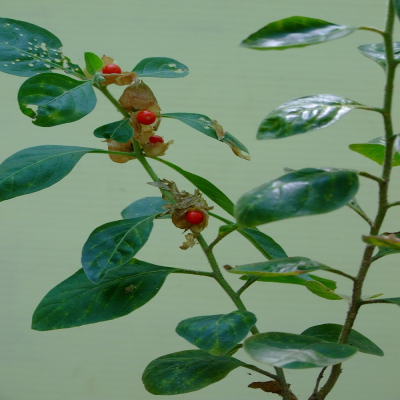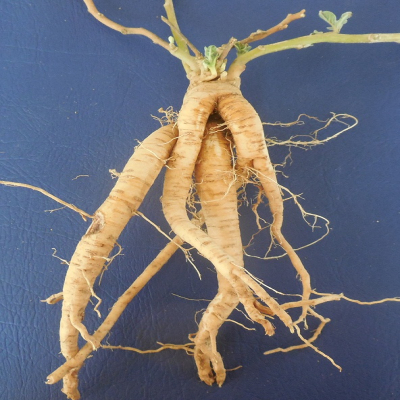Withania somnifera (Linn.) Dunal
Family : Solanaceae
Group : Rejuvenatives, Aphrodisiac/spermatogenesis
Parts Used : Root , Leaf
Vernacular Names :-
| English | : | Indian ginseng |
| Malayalam | : | Amukkuram |
| Hindi | : | Asgandh |
| Sanskrit | : | Aswagandha |
| Gujarathi | : | Asan |
| Kannada | : | Viremaddinagadi |
| Tamil | : | Amukkiram |
| Telungu | : | Vajigandha |
Distribution and habitat: Aswagandha is believed to have oriental origin. It is found wild in the forests of Mandsaur and Bastar in Mandhya Pradesh, the foot hills of Punjab, Himachal Pradesh, Uttar Pradesh and western Himalayas in India. It is also found wild in the Mediterranean region in North America. In India it is cultivated in Madhya Pradesh, Rajasthan and other drier parts of the country.
Botany: It is erect, evergreen, tomentose shrub, 30-150 cm in height.
- Roots : Stout, fleshy, cylindrical, 1-2 cm in diameter and whitish brown in colour.
- Leaves : Simple, ovate, glabrous and opposite.
- Flowers : Bisexual, inconspicuous, greenish or dull yellow in colour born on axillary umbellate cymes, comprising 5 sepals, petals and stamens each; the two celled ovary has a single style and a bilobed stigma. The petals are united and tubular. The stamens are attached to the corolla tube and bear erect anthers which form a close column or cone around the style. Pollen production is poor.
- Fruit : Small berry, globose, orange red when mature and is enclosed in persistent calyx.
- seeds : Small, flat, yellow and reniform in shape and very light in weight.
Properties: Roots are astringent, bitter, acrid, somniferous, thermogenic, stimulant, aphrodisiac, diuretic and tonic. Leaf is antibiotic, antitumourous, antihepatotoxic and antiinflammatory. Seed is milk coagulating, hypnotic and diuretic.
Chemical constituents: Aswagandha roots contain alkaloids, starch, reducing sugar, hentriacontane, glycosides, withaniol and fatty acids.
Uses:
- Indian ginseng is considered to be one of the best rejuvenating agents in ayurveda. Its roots, leaves and seeds are used in ayurvedic and unani medicines, to combat diseases ranging from tuberculosis to arthritis.
- Roots are prescribed in medicines for hiccup, several female disorders, bronchitis, rheumatism, dropsy, stomach and lung inflammations and skin diseases. Its roots and paste of green leaves are used to relieve joint pains and inflammation.
- It is also an ingredient of medicaments prescribed for curing disability and sexual weakness in male.
- Leaves are used in eye diseases. Seeds are diuretic. It is a constituent of the herbal drug ‘Lactare’ which is a galactagogue. It improves physical strength and is prescribed in all cases of general debility.
Formulations: Aswagandharishtam
Agrotechnology
Soil and climate: It is a tropical crop growing well under dry climate. The areas receiving 600 to 750 mm rainfall is best suited to this crop. The roots are fully developed when 1-2 late winter rains are received. Sandy loam or light red soils having a pH of 7.5- 8.0 with good drainage are suitable for its cultivation. It is usually cultivated on poor and marginal soils.
Propagation: Propagated through seeds. It is a late kharif crop and planting is done in August. Seeds are either broadcast-sown or seedlings are raised in nursery and then transplanted. Seed rate is 10-12 kg/ha for broadcasting and 5 kg/ha for transplanting. In direct sown crop, plants are thinned and gap filling is done 25-30 days after sowing. Seeds should be treated with dithane M-45 at 3 g/kg of seeds before sowing. Seeds are sown in the nursery just before the onset of rainy season and covered with light soil. Seeds germinate in 6-7 days. When seedlings are six weeks old they are transplanted at 60 cm in furrows taken 60 cm apart.
Manuring: The crop is mainly grown as a rainfed crop on residual fertility and generally no manure or fertilizers are applied to this crop. However, application of organic manure is beneficial for realizing better yields.
After cultivation: One hand weeding 25-30 days after sowing helps to control weeds effectively.
Plant protection: No serious pest is reported in this crop. Diseases like seedling rot and blight are observed. Seedling mortality becomes serious under high temperature and humid conditions. The disease can be minimized by use of disease free seeds and treatment with thiram or deltan at 3-4 g/kg seed before sowing. Further, use of crop rotation, timely sowing and keeping field well drained also protect the crop.
Harvesting: Aswagandha is a crop of 150-170 days duration. The drying of the leaves and reddening of berries indicate the maturity of the crop. Harvesting usually starts from January and continues till March. Roots, leaves and seeds are the economical parts. The entire plant is uprooted for roots, which are separated from the aerial parts. The berries are plucked from dried plants and are threshed to obtain the seeds. The yield is 400-500 kg of dry roots and 50-75 kg seeds per hectare.
The roots are separated from the plant by cutting the stem 1-2 cm above the crown. Roots are then cut into small pieces of 7-10 cm to facilitate drying. Occasionally, the roots are dried as a whole. The dried roots are cleaned, trimmed, graded, packed and marketed. Roots are carefully hand sorted into four grades.


